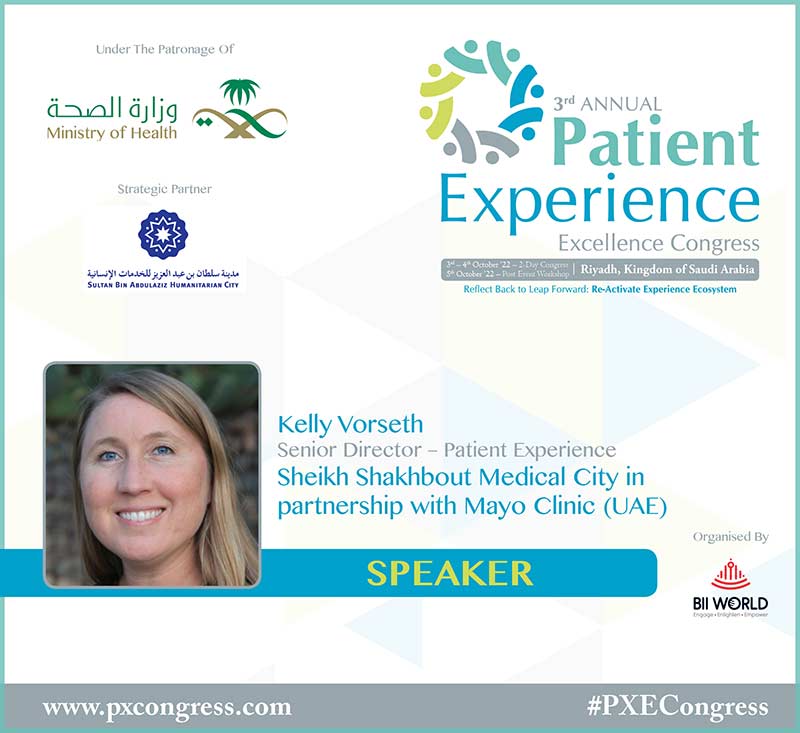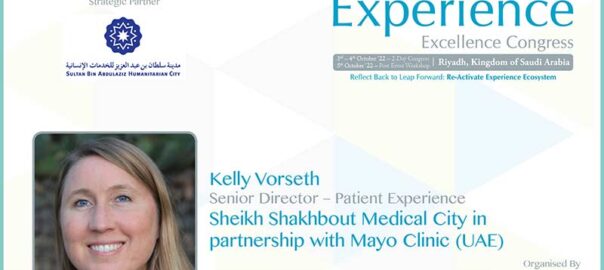Kelly Vorseth,
Senior Director of Patient Experience at Sheikh Shakhbout Medical City (SSMC)
What key areas should health care providers look at when addressing the needs of patients?
A patient’s journey is not always easy. It can be frustrating or uncertain and generates a lot of fear and anxiety for the patient and loved ones. We cannot allay all their feelings and anxiety but what we, as health care providers, can do is utilize processes and models that place patients at the heart of what we do.
One model is making sure we connect with our patients in a way that makes them feel understood. In this digital age, we cannot lose this human connection. Understanding where our patients are coming from, empathizing and validating their concerns, lets them know we do care and we are on this health care journey with them.
Another important element is involving patients in their journey. With patients being more empowered than ever when it comes to their health, they expect more from their providers than just the ability to use digital solutions, like an electronic health records portal, to access test results which they might not fully understand. Health care organizations need to take it one step further to deliver a truly patient-centered experience.
One way we do this at SSMC is by emphasizing greater attention to the pre- and post-patient visit experiences. In doing so, we help set expectations for the patient and their family, taking the time to explain their journey and allowing them to be part of the decision making, allows the patient to feel more cared for and more informed along the way.
How does SSMC approach enhancing the delivery of the patient experience?
Since 2019, SSMC, which is one of the UAE’s largest tertiary hospitals, has been working towards bringing integrated human-centric and compassionate care in the GCC. Our foundation lays the groundwork for our success. This is centered around our unique model of care which defines how we provide care to our patients, the environment of our employees and how our teams work together to address complex situations and cases.
Through tried and tested processes and methodologies from our parent company, Mayo Clinic, SSMC places immense efforts on understanding our patients. By delving into what they need from both a medical and an emotional standpoint, we as a workforce, are then better positioned to provide quality care for all their needs.
SSMC’s model of care also provides patients access to a team of locally and internationally trained physicians and allied health staff, who work seamlessly together to offer a Category of One service in health care.
How do you see the patient experience changing in the near future? What can organizations do to meet those needs?
Change is constant, but what will always matter the most is continuously improving our service to our patients. To do this, as health care professionals and organizations we must be fluid and adapt to that inevitable change.
Expected change that we are already seeing is more digital demand, but without losing the compassionate touch. As a health care institution, we need to provide digital solutions throughout our patient’s entire health care journey to provide enhanced services and easy to find information. However, at the same time, with every interaction, we want our patients to feel the compassion, connection and trust in care we are providing them. It has to be a balance and we have to let patients choose how they want to receive the information.
Embracing both traditional and digital solutions plays a large role in the ability to deliver a holistic patient-centered experience. At SSMC, in partnership with Mayo Clinic, we take a unique approach bringing research and education directly into patient care. This three shield approach allow new advancement and discoveries to be transferred into clinical care faster. It means new learners see and adapt to best practices in medical treatments, service excellence, professionalism and system-based practices, which ultimately translates to SSMC being a differentiator to our patients and to the health care community, now and into the future.



